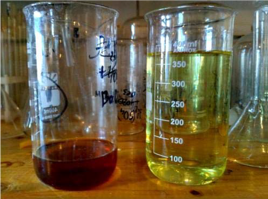
AquaOil srls
Via Terracina 27, 00177 Roma (Italia)
C.F. - P.IVA - № registro imprese 16213571009
Numero REA RM - 1641982
www.aquaoil.info – pec : aquaoil@pecodc.it
Email: info@aquaoil.it
Telefono: +39 349 342 3348
Applied research for innovation and development
AquaOil

HYDRODESOLFURING AND HYDROCRACKING
The technology called Plasma Transonic System is a new technological solution for processing hydrocarbons, aimed at modernising processes and reducing industrial costs.
What the Plasma Transonic System does
- CRAKING of products and raw materials from various refining units
- HYDROCRAKING of heavy oil products
- HYDROCRAFTING of light and heavy oil products
The technology is based on three principles combined in a single device:
1. The generation of unbalanced (cold) plasma in the two-phase flow of the raw material to be treated
2. The transonic effects in the flow of the raw material being treated, which allow homogeneous multi-component mixtures of oil products to be obtained
3. The addition of additional hydrogen in the plasma discharge.



OPERATION AND EFFECTS
1. Acceleration of fluid matter up to a speed of 40-60 m/sec.
2. Conversion of up to 50% of the volume of the raw material into a vapour-gas state.
3. Formation of a supersonic two-phase flow (vapour-gas-liquid).
4. Formation of energy-intensive zones in which powerful cavitation and heat/mass transfer, homogenisation and mixing effects occur
5. Plasma generation and cracking (maximum intensity and operation over a wide range of electric current frequencies) "
6. Electrolysis in the field where the plasma is ignited (steam, water) with atomic hydrogen production (hydrogenation )
7. Cracking processes of raw materials followed by hydrogenation
8. Flow transition from supersonic to subsonic, pressure jumps and condensation.
9. The process is completed with single-phase flow at subsonic speed.
THE BENEFITS OF THE TRANSONIC PLASMA SYSTEM
Reduction of up to 50 per cent in the cost of implementing hydrocracking and hydro-refining processes.
Transition from uncontrolled thermal reactions to controlled plasma reactions.
The temperature and process pressure at which these reactions are initiated are not comparable to conventional reactions.
Possibility of hydrotreating heavy oil products
Low energy consumption of 3 to 5 kW per tonne of processed product
Reduced equipment needed to carry out the process
Reduced mass characteristics
Atomic hydrogen is produced from water by plasma discharge.
Minimal emissions of harmful substances into the atmosphere
New mechanism of cracking and hydrogenation reactions
HYDROCRACKING MECHANISM OF HEAVY HYDROCARBONS WITH THE TRANSONIC PLASMA SYSTEM
- breaking of C-C, C-S hydrocarbon chains in the plasma discharge
- formation of unclosed hydrocarbon bonds (free radicals)
- introduction of superheated water (steam) into the plasma zone under overpressure
- electrolysis of water with formation of active groups (atomic hydrogen and OH groups)
- reactions of atomic hydrogen with hydrocarbon radicals
- conversion of heavy high-molecular fractions to low-molecular fractions (hydrocracking)
- reaction of OH groups and hydrocarbon radicals to form high molecular weight alcohol compounds
- obtaining a petroleum product with a higher composition of low boiling point components.
CONCLUSIONS / DEGREE OF SYSTEM DEVELOPMENT
In-depth study of the PLASMA TRANSION SYSTEM
1. Examinations and practical experiments with oils, light and heavy petroleum products (from petrol to tar).
2. The system is patented and accompanied by reports, proceedings and conclusions.
3. Experiences and applications at refineries and thermal power stations.
HYDROTREATMENT OF HEAVY HYDROCARBONS USING THE TRANSSONIC PLASMA SYSTEM
Tuning the plasma discharge to operate at narrow frequencies in the resonance of organosulphur compounds for greater efficiency on the sulphur target component.
Breakage of C-S and partially C-C bonds
Water droplets (vapours) form H and OH atomic groups
Sulphur radicals react with hydrogen and are expelled as gases.
Hydrocarbon radicals react with hydrogen and OH groups.
The result is a refined petroleum product free of sulphur compounds and with a higher content of light components.
THE TRANSONIC PLASMA SYSTEM
Research and Development
1. Laboratory experiments with plasma discharge were conducted on petroleum products ranging from gasoline to heavy fuel oils.
2. The preparation of stable mixtures of petroleum products in plasma discharge with results impossible under normal conditions without surfactants and stabilisers was confirmed in practice.
3. The decomposition of various liquid and gaseous compounds in the plasma discharge (H2O=H+OH, CO2=CO+O) has been confirmed in practice.
4. It was found that the compounds in step 3 have very high binding energies, from which it follows that compounds with lower C-C and C-S binding energies can be separated just as intensively in the plasma discharge. Further investigations are in progress.
5. A patent registration of the new technology is planned.